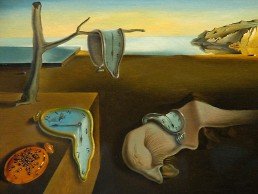Deceive the Eye-Trompe l´oeil
Definition
Trompe l´oeil in French, meaning Deceive the Eye in English, is a painting technique used in Art so as to create an optical illusion where objects have depth and perspective. The use of perspective and shades make objects appear in three dimensions. Distant views, skies, open windows have been created by adding fake columns and ornaments. The artist´s intention is to make the audience believe that the objects are solid and real. This painting technique creates an illusion that generates joy to the observer.
Characterization
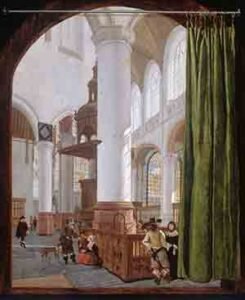
This technique incorporates different types of objects or structure. Fake backgrounds with fireplaces or instruments left by chance are simulated. Elements unconnected with the artwork are included, this gives a sensation of reality at the same time. Artists used wet plaster, added pigments to create the three dimensions effect. Likewise, the faux finishing which involves adding streaks with wood granules to achieve said effect.
Historic evolution
This is an ancient technique. However, realistic artworks were only acknowledged by the year 1800.
Antique Greece and Roman Empire In 460 BC Greece, a contest between two painters was carried out, one of them called Zeuxis performed an artwork of a tavern, and it was so realistic that birds tried to eat the grapes. Once Zeuis´s work was finished, his counterpart Parrhasius asked Zeuis to evaluate his artwork for which Zeius asked that curtains are drawn first. Since it was something impossible to do because these curtains belong to the painting, which achieved such a significant impact to the jury who appointed Parrhasius as the winner. In the Antique Rome and in Pompei a mural could replicate a window or a door to the effect to recreating a room by using wet plaster to give a sensation of depth.
The Renaissance
The artist Miguel Ángel Buonarroti (1475- 1564) was architect, sculptor and painter. Among its artwork we can mention the ceiling of the Sistine Chapel where he represents his interpretation of the biblical Genesis. Miguel Ángel performed the frescoes in four years, which were made from fresh lime, using wet plaster. Colors were applied when walls were still wet which made colors change once dried. Frescoed painting was definitive, the scene approached had to be finished on the same day. He painted angels and biblical characters, adding deceiving columns and beams.
The artist Leonardo Da Vinci (1492-1519) considered a great visionary, painter, sculptor and engineer made contributions to painting techniques such as the blending technique which is the overlay of painting coats achieving blurry outlines and contrast between illuminated and dark areas.
In his mural painting the Last Supper where Leonardo painted about a religious theme, Jesus can be seen in the middle of the composition surrounded by his apostles and at the back we find a window, which stresses the perspective. This was a frescoed painting performed by Leonardo using oil and painted on Gesso (mixture of plaster and chalk) which compromised its durability, since with time this painting started to peel off.
Andrea Mantegna (1431-1506) was a renowned artist during the Renaissance. He did Frescoed painting on ceilings, and he stands out by using perspective and foreshortening used to represent figures perpendicularly to the canvas or paper, there a part of the figure is twisted with respect to the rest of the body, giving the illusion of spaciousness to the audience. He is one of the most renowned artists during the Renaissance, among his most significant artworks we can mention the Frescoes on The Ovetari Chapel in Italy and the Camera degli Sposi ("Bridal Chamber" which is a portrait of a traditional family and at the back of the painting an oculus to deceive the eye which simulates the existence of an open sky.
In the XVII century, breakthroughs of the perspective theories, enabled the artists of that time to use this technique to open ceiling and wall painting which was call Quadratura, this can be observed in the paintings of Andrea Pozzo (1642-1709) at the Sant'Ignazio Jesuitical Church in Rome. The artist painted lateral walls and ceiling by making it appear vaulted when in fact the ceiling was flat and populated by suspended figures on top. In the Jesuitical churches in the XVI and XVII centuries, artistic painters use the trompe l’oeil technique on ceilings and domes where they represented the images of Jesus, Mary and saints.
Flemish Painters
The Deceive the Eye style reached its apogee with the use of this technique by Flemish painters of the XV to XVIII century, who created three dimensional optical illusions in their artworks. Objects seemed to pop out of the frames and from open furniture and its representations were so real which prompt the audience to take these objects from the paintings. These artists amazed the audience by the realism of details and the innovative use of oil painting, applying the new techniques which enabled them to achieve said illusions with versatility.
Among artists who stand out we can mention , Cornelis Norbertus Gysbrechts (1630-1675) Flemish painter who is characterized by painting taverns and vanity tables in a false perspective by representing several objects such as letters, books, hunting objects and musical instruments. In its artwork called The Reverse of a Framed Painting, he represents the back side of a painting, with its wooden frame and canvas, where he adds the number 36, catalogue index to be auctioned.
Samuel Van Hoogstraten (1627-1678) Dutch painter (Baroque golden period) is renowned by the use of the Deceive the Eye-Trompe L’oeil technique in his artwork “Old Man Looking through a Window” where a head is seen standing out of a window. In the Jesuitical churches of the XVI and XVII centuries the trompe l´oeil technique was applied to ceilings and domes where images of Jesus, Mary and the Saints where represented. This technique reached its apogee with painters from the Netherlands in the XVII century and reflected in the XIX and XX centuries.
At Present

Contemporary artists use Deceive the Eye in murals on public spaces, street posters, sculptures performed in public spaces, and play freely with illusionary images, evoking historical facts, constantly changing our visual reality. This technique is also applied to tables, differences pieces of furniture and decor. It is used in theatrical set designs by realizing interior murals thus creating the illusion to be in a more spacious and deeper place. This technique can also be found in street artists who design and perform works called Pavement Art which have a brief duration since these tend to disappear from streets after a while. The artifact in the Deceive the Eye- Trompe L’oeil is to deceive the eye and how to discover the true reality. This is the intention of the artist, to deceive the audience by substituting reality for illusion. This Art generates joy from deception of the eye and optical illusion.
Abstraction
Emergence of abstraction.
The biggest change in non-figurative art was the elimination of the reference to the world of identifiable objects. At the beginning of the twentieth century, abstract art was a revolutionary concept, in which identifiable people and objects were set aside, floating shapes similar to beings and geometric things began to appear, large areas of color covering the entire canvas and horizontal and vertical lines.
The deepest change was to eliminate the reference to the world of identifiable objects. The art without representation.
The Impressionists had reduced the domain of realism over the physical world and sometimes were near to abstraction.
The notion of abstraction was not entirely new, it is the case of the painter J. William Turner whose swirls of colors are identifiable with ships in the sea. The Cubists divided the objects into multiple planes, not intended to abolish the representation, but only to reform it in its spatial dimensions.
The Expressionists and Fauvists represented nature by separating themselves from the colors they usually used. The artists' paintings had not yet abandoned concrete reality and did not dispense with figures and objects.
Pioneers of abstract art.
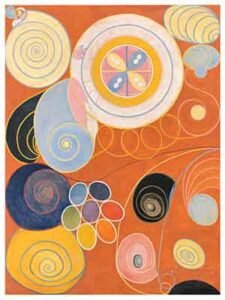
When referring to the pioneers of abstract art, we must mention Hilma af Klint, of Swedish origin (1862-1944). She creates her works before the presentation of Kandinsky's works in 1911, who is historically said the creator of abstract art. This situation is due to the fact that the works of Hilma af Klint were not released until 1986. This was partly due to her own decision and partly influenced by Rudeel Stanley, president of the anthroposophy society (deals with the search of the hidden wisdom and the spirits), to which she adhered, who suggested that these works not be disclosed at that time, since they would not be recognized or accepted.
Hilma af Klint studied at the Royal Academy of Art in Stockholm because they accepted women there, which was not usual at that time. She transmitted the spiritual issues through art, was a portraitist and landscape artist, but her main work was the abstract one, in which she embodied a supra earthly world, far from visual appearances in order to reach a knowledge beyond the material.
In 1892 she formed the group of The Five, who aim to capture astral knowledge in art.
Making automatic paintings and collective drawings in the séances. Her extrasensory experiences guided her in the creation, investigating the line, the color, the symbols, the word, the atoms, the matter and the energy. She was interested in duality, good and evil, woman and man, religion and science. She deployed in her works concentric circles, ovals, spirals, pyramids and triangles (symbol of the spiritual development of man).
She left a prolific work, whose merit was to create for the future, leaving us a vision of life away from material.
Some historians define abstraction as the natural result of a formal representation process that inherits the teachings of Cubism with Kasimir Malevich and Mondrian as the pioneers of that process. Others point out that abstract art is the consequence of a spiritual search with deep roots in Expressionism with Kandinsky's case. His work evolved into abstraction based on colorful Expressionism.
The Blue Rider was the name imposed on a group of German Expressionists in 1911. Its most important representatives are: Vassily Kandinsky and Franz Marc. Kandinsky and his group thought that healing could be done through art, and achieve a new art, spiritual and transcendent. Kandinsky expressed that the spirit of modern man was oppressed by materialism. In this situation, man must find a new spiritual sense. Painting and arts are in a return to spiritual, and an approach to it is to reach abstraction, to the elementary.
For Kandinsky (Moscow 1866-1944) the composition of chromatic forms and drawings, arise from an inner imperative, and express an intimate vision of the human soul. His abandonment of figuration is due to the need to find another way to project his visualizations that overcome the apparent contradiction between form and color. The artists must be creators of their own and personal work, and must express it according to the conditions of their time (the temporal), and reflect the content of art from all ages, (the eternal), which responds to mystical needs. Each form has an inner content for them, and is the outer manifestation of that content. The harmony of the forms must be based on an inner need. According to Kandinsky, painting is an art, and art, in its global aspect, is not a useless creation of objects that fall apart in the emptiness, but a useful force that serves the development and awareness of the human soul.
Kandinsky joined the Bauhaus school in 1922. In his book Point and Line On the Plane, he intended to lay the foundations for a scientific theory of art. He an
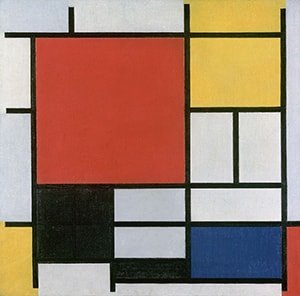
alyzes the point, the line and the plane, convinced that the forms are variations on a single theme that presents infinite possibilities, by the action of opposites, similarities, etc. His work is the result of a meticulous composition, which requires outlines and diagrams. Kandinsky studied the psychological influence of color and the emotional power of music. He considered that the colors had a deep expressive force and possessed their own qualities. Example: the vermilion expresses a spiritual vibration, like a flame.
In turn, Malevich and Mondrian reach abstraction through a process linked to Cubism, in which spatial dimensions are challenged. For Malevich (Moscow 1878-1935), according to his statements, he achieves an art in which the ability to create a construction does not derive from the relations between form and color, nor in the aesthetic gesture, but is built on the basis of weight, speed and direction of the movement, thus reflecting the supremacy of pure feeling, or the sensation in the pictorial arts, which he called Suprematism.
The object has no meaning for R. Malevich, he sought non-objective representation. We observe him in his series of paintings White on White, or Dynamic Suprematism. There, the geometric shapes are abstract. He tries to express deep feelings and expressions of personality.
Piet Mondrian's research (Netherlands 1872-1944), propose as a dogma the structuring of the support plane with vertical and horizontal lines, which determine a set of planes painted with pure colors: white, black and gray. His desire was to achieve personal purity and divine simplicity. He used the primary colors, in addition to black and white. His style was austerity. His work: "Diamond painting in red, yellow and blue" is a dynamic work with a great balance.
The pioneers Kandinsky, Malevich and Mondrian achieved their style in different ways, but all of them aimed to combat the limitations of socially dominant materialistic values, with a series of new and deep values. Their creative approach was steeped in Eastern esoteric beliefs, ancient philosophy and recent mystical literature. They wanted their art could offer the foundation of an orderly and spiritual life.
What is abstract painting?
How we define abstract painting if we do not emphasize its formal structure. According to G. Deleuze and F. Guattari, it is a construction that does not have a direct reference to the outside world, with planes of uniform colors, or lines that change, without interior or exterior, without shape or background, and geometric figures or continuous lines. All of them are manifestations of the forces that the artist sets in motion when creating.
Without identifiable persons and objects, it is art without representation of the object.
Abstraction in art allows to achieve an expression of the artist in total freedom, so he can fully manifest his/her inner world.
Abstract painting allows a release of the shapes of objects as they are. That way it is achieved deep intimate expression with feelings and emotions. What is painted or drawn is not reality but what everyone perceives, imagines or feels what it is. The inner world of the artist is manifested, expressed. The variations are multiple, as artists have expressed throughout history. The pure stain, geometric shape, color planes. Therefore, the expression abstract painting is more comprehensive in the pictorial plane than its term indicates. That is why abstract art has been divided into two large fields: geometric and lyrical. However, the important accent of abstraction is not the formal part of the work, but the way in which the artist transmits his/her forces and makes them visible through chaos, sublimation, clean, clear, flat spaces, color planes or geometric figures.
Surrealism
Birth
The Surrealist Movement was born in Paris as a literary movement, which evolved and influenced the arts, and especially painting and photography. André Breton, French writer, publishes in 1924 the first surrealist manifesto, influenced by the theories of Sigmund Freud, who intended to discover the subconscious through the images that emerged from dreams, which challenged the real world. The painters explored the mysteries of the mind, its irrationalities and fantasies, searching a new artistic freedom. The surreal term means to go beyond reality.
Its initiators
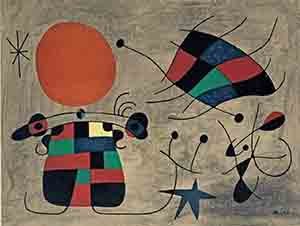
Surrealism has a high number of painters, among the most prominent are: Marx Ernst, Miró, Masson, Picasso, Tanguy and Magritte.
There are two trends in Surrealism: the oneiric, of dreams themselves, and automatism, which started from free association. They used photography in which they joined the real and the surreal through photographic techniques. They also used provocative issues, such as violence and sex. Art made it possible to express what the artists had lived after the World War I. And they wanted to achieve new styles and forms of artistic expression.
Giorgio de Chirico (1888-1974) gave rise to what we call metaphysical painting and influenced surrealist painting. He painted real places and objects in strange contexts, resulting in disturbing images. He gave special importance to the world of dreams and the subconscious, and the juxtaposition of objects which was a distinctive note of surrealism. His work turned later into a classicism.
Marx Ernst (1891- 1976), German artist, nationalized French, developed new techniques to express his own unconscious behaviors. The frottage (rubbed a pencil on paper on a surface with irregularities). He made collages using technical and scientific book clippings, worthless. He founded the branch of Dadaism in 1919, which was an artistic movement formed by artists and writers dissatisfied with the atrocities of war. Through their works they rebelled themselves against established art, incorporating irrational and imaginative concepts in their works. He contributed to the development of Surrealism from Dadaism, using childhood memories to influence his works.
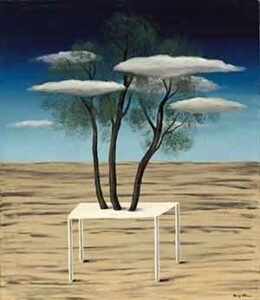
Joan Miró (Barcelona 1893-1983). His work is characterized by automatic drawing, transferring the unconscious processes to paper. He was an introspective artist that rejects the traditional conventions of painting. As a playful artist, he gave great value to children's drawings, although in his work there is a degree of rebellion; he said he wanted to destroy painting, which was a Dadaist concept. Surrealist painters gave great importance to amateur artists, whose painting was based on creative impulses, without aesthetic laws. Also to children's drawings and painting of sick people ... always looking for fantastic or absurd images.
René Magritte (1898-1989). He stood out for a real Surrealism, a great imagination and paradoxical visual statements. In his work The Empire of Light, it can be seen both night and day, a surreal and irrational dream scene.
Salvador Dalí (1904-1989). Owner of an eccentric personality, he joined the surrealist group in Paris. His method that he called critical paranoid, was based on delusional associations. His work explores unconscious desires. He painted unpleasant and surprising images with meticulous realism. In his work The Persistence of Memory, with its melting clocks, he gives us the feeling that time drove crazy.
Expansion
The surrealist movement spread to other nations and had a great influence on film and the world of the arts in general.
Impressionism
Emergence
In the mid-nineteenth century, painters, attentive to social and scientific changes managed to connect with their environment in a different way. The paintings of academic study, were not natural in contrast to the external reality. Impressionism emerged in France in 1860. The impressionists painted abroad, immersed in nature, in order to capture the light in its constant changes, and grasp the immediacy and transience of the moments. This way of painting was called plein-air, in the open air, they finished their works in the place where they worked. Scenes from the daily life of Paris and the suburbs.
They were not openly accepted as Impressionists aware that they did not follow the guidelines given by the art academy. Its main representatives were Claude Monet and Aguste Renoir. The realistic style showed life in its crudest aspects. It was an art that showed social reality. Impressionism was not social, it was more to show personal experiences. We can consider its beginnings from its first exhibition in 1874 to 1886. However, we find outlines of impressionism from realism to post-impressionism.
New Techniques
The practice of outdoor painting, made the works were clear, without black shadows, the shadows are transparent and colored in nature. Objects and shapes vary according to the degree of luminosity. The objects and figures lose consistency in a constant change. They used juxtaposed brushstrokes of pure tones, the black is reduced to its minimum
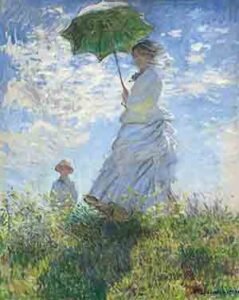
expression. The contours are undefined, and the forms are expressed with short strokes and vivid colors. Each element was carried in its greatest simplicity.
To paint the lights and shadows the Venetian method was imposed, painted opaque lights and shadows and then added transparent glazes. Another feature was to load the surface uniformly. The clear bases were more persistent because they conserved their luminosity with the passage of time. This does not happen with dark shadows since they darken more with time.
Three factors influenced the development of this technique: the mechanical grinding of the colors, the binding oils and the additives used to keep the paint homogenous in the newly emerging tubes. The artists prepared the paint only when they needed it, but the expansion of the commercial colors in the nineteenth century gave rise to the need for them to retain their consistency before using them.
Impressionist painters take advantage of scientific advances, industrial technical advances, carrying out new research at the service of expressing through this the individual subjectivity. Achieving to capture a magic in the chromatic ranges, and the fugacidad of the chromatic elements of the luminance variations.
Chevreul chemist contributes his research on the simultaneous contrast of colors and harmony of colored objects, and the application of colors to the industrial arts over chromatic circles (1864). Chevreul divided the colors into primary (pure) and binary (formed by two colors), a binary color is enhanced next to the primary that is not part of its composition. He formulated the law of the simultaneous contrast of colors, demonstrating that the juxtaposition of colored objects modifies their optical nature, thus each color always tends to color itself of its complementary, and if both juxtaposed objects are colored by a common element, it gradually disappears.
Photography is for the Impressionists a help, it serves as a means to see better, an apprenticeship of sight, putting technique art service. The influence of Japanese art, which since mid-century is felt in Europe especially in Paris, we find in many artists attracted by the chromatic simplicity, the synthetic treatment of light and shadow. Informality in front of the laws of perspective, the absence of modeling of figures.
Evolution
They limited themselves to choosing those aspects of society and nature that suited their optimistic view of the world. Good part of its propagation a century later is due to the naturalness, to the hedonism with which they manifest the most pleasant aspects of a bourgeois little life with naturalness, surrounded by a maternal nature and a society whose problems do not express.
Its main representatives in Paris are: Monet, Pissarro, Sisley and Renoir. His predecessors are Jongkind and Boudin. Ind

ependent artists were Manet and Degas. Other artists who take new directions are Seurat and Signac, creators of pointillism or divisionism, Gauguin and Van Gogh tended to a symbolic expressivism, Toulouse Lautrec to Expressionism and Cezanne, ancestor of Cubism.


.png)


